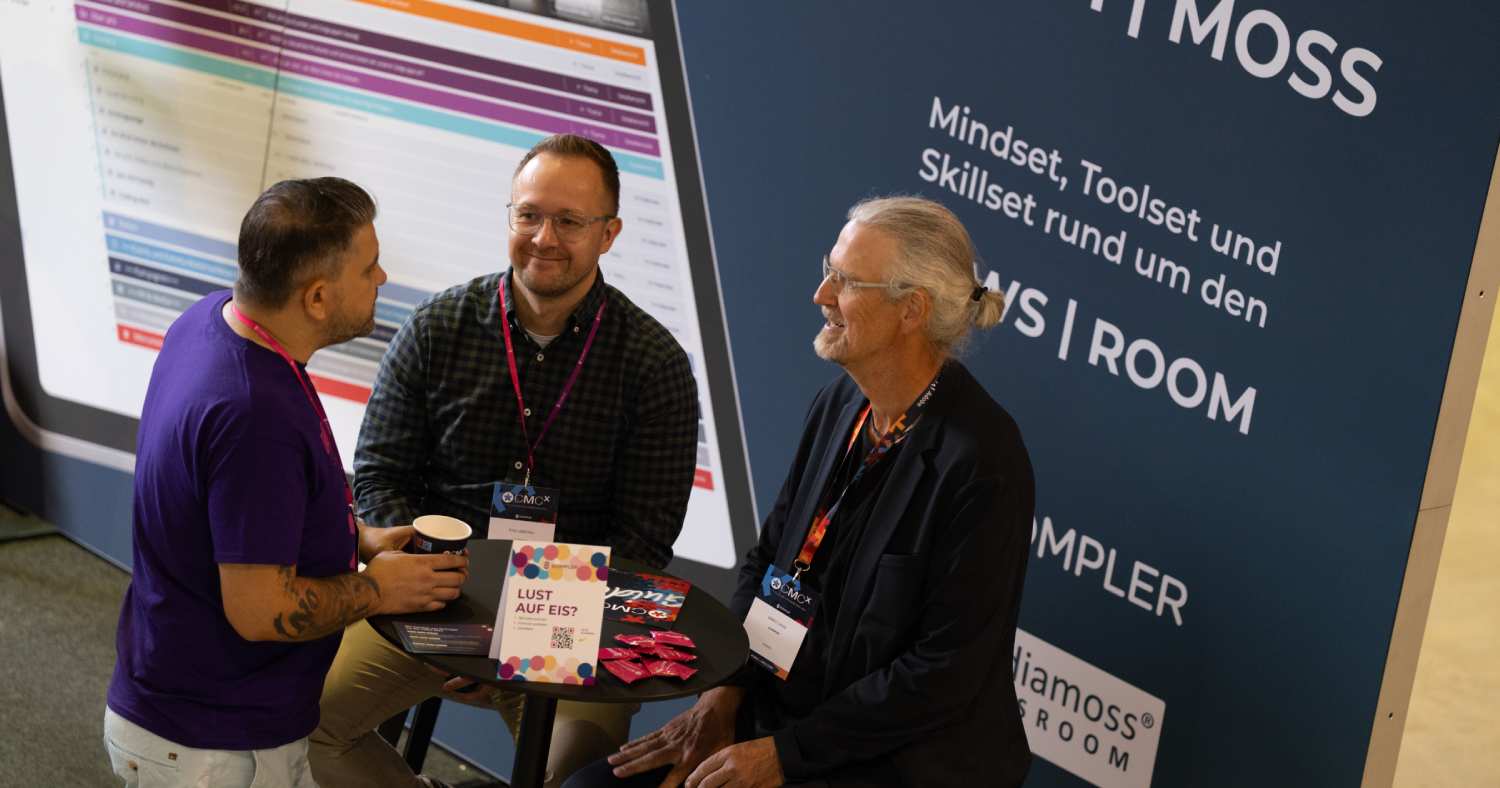Interactive infographic: How to feed the content monster without being eaten
So here too. There it is again, this "content marketing". Hasn't everything been said about it so slowly? Isn't it just another buzzword? And isn't content marketing just "old wine in new bottles"? Or to put it another way: do we really need to look at it in more detail?
A buzzword with a lot of substance
The answer to all these questions is: "Yes". Yes, the term is indeed hyped, exaggerated and overused. And yes, you have to deal with it. Even if the term is unfortunately largely devoid of content. That sounds strange for a marketing discipline that is (supposed to be) about "content". But you still have to deal with it - or rather: precisely because of it. Because there is far more to the term than meets the eye. It is more than just another buzzword or hype. It is the reaction to a very real change in the market. And it is an enormously exciting, fascinating and multifaceted topic. So as a marketing person, you should understand it well - and then you can still decide whether to do something or not.
Everyone is doing content marketing at once
Unfortunately, it's not quite so easy to understand. This is mainly due to the fact that almost everyone in the field of communication today is jumping on the bandwagon: corporate publishers, SEOs, PRs, advertisers, editors, online marketers... they all claim to be better at "content marketing" than the others. Each of them looks at "content marketing" from their own perspective, they all pursue different goals and they all understand "content marketing" a little differently. Unfortunately, this leads to a total cacophony in the market. At the moment, everything that's not up to scratch is referred to as content marketing. And in the end, nobody really knows what it is anymore. The only thing that everyone agrees on is that you should somehow offer "useful content".
Content is actually something quite old...
However, this "useful content" is anything but new. For example, when the tire manufacturer Michelin wanted to do something good for its customers at the end of the 19th century, it designed a guide for garages, including tips on how to handle cars and tires. A good 20 years later, in the 1920s, Michelin expanded his advice to include hotels and restaurants - which made sense, as drivers had to stop off at some point. Thus the "Michelin Guide" as we know it today was born. And there are many other examples of product manufacturers giving tips on how to use their products, especially food manufacturers who printed recipe tips on their packaging early on. Just think of Kaiser Natron or Dr. Oetker. In this respect, everything is correct: the basic idea is anything but new.
People are fed up with advertising!
So where does the current interest in content come from? Why is the topic of "content" so relevant right now? This is anything but a coincidence. Because something has happened in the last few months and a few years that is changing communication quite permanently: People, especially digital people, are fed up with "advertising". Really fed up. They are fed up of being shouted at from all sides, of being constantly interrupted while doing what they like to do and what they are interested in, and usually with things that don't interest them. And he's tired of being lured in with such dubious methods that insult his intelligence, only to realize that it was all just a zero number. And this rejection has now reached a tipping point. Enough is enough!
Ad blockers on the rise everywhere
The most blatant and visible effect of this advertising fatigue are the "ad blockers" on the internet. According to expert estimates, several hundred million people now use these small programs that simply hide advertising on websites. So they are gone. Peace at last! But the same thing also happens in front of the television: advertising is zapped away. Or in magazines: Advertising is skimmed over. If people still read magazines or watch TV at all. The trend is clearly moving towards "on demand" offers: Films no longer come from the TV program, but from the video store (or from Apple TV or Netflix or Sky), and music no longer from the radio but from Spotify & Co. And the movie or music is not constantly interrupted by advertising.
Google Panda and Penguin have changed an entire industry
And this trend is now becoming established in every area of life: For some years now, even Google has been checking more and more successfully whether good content is hidden behind the links. The so-called Penguin and Panda updates have changed an entire industry - namely the SEO industry. Anyone who only creates empty texts with a snappy headline and a few keywords no longer has a chance of ranking well. But the SEO industry has lived on this for almost 20 years! And in social media, too, only what meets the needs of customers is successful. Here, too, you need good texts with new information, enriched with varied media and presented in a great way. Don't ask me how Google does it - if I knew, I'd be a millionaire.
And how does that work with content marketing?
So now it comes, the question of "How does it work now?". Unfortunately, it's not so easy to answer. Simply because there is no "one" way. If you just look at the current "awards" in the field of content marketing or look at the "best cases" at conferences, you will notice one thing: On the one hand, there are many different approaches, but on the other hand, a lot of them seem familiar. And experience shows that companies at different stages of development have different approaches. Today, we talk about five to six different "content maturity levels" in which the organization of content marketing becomes increasingly complex. However, I would like to reduce this to two, namely "tactical content marketing" as the simpler and "strategic content marketing" as the more complex variant.
The simple version: Tactical content marketing
Tactical content marketing is what we see most often at conferences today and what most companies do. In the vast majority of cases, it starts with a (single) department. They usually start by trying out what "content marketing" can achieve. How it does this and what comes out of it depends primarily on which department is responsible:
- When the sales department of a B2B company does content marketing (or the very sales-driven marketing department), then content marketing usually means creating a white paper or a webinar, and then a landing page is created, advertising is done, and the campaign is considered successful if a lot of interested parties have left their email address. This is then called "leads". The starting point for the "strategy" is usually a format, i.e. a white paper, a study or a webinar. And the implementation is then based on this format.
- When the sales department of a B2C company does content marketing (or the very sales-driven marketing department), the result is usually something funny. Often a video. And this is then "seeded" and distributed via all the company's own channels. Alternatively, you look for a blogger and they use their own reach. This is called "influencer marketing". The campaign is considered successful if it has generated a lot of traffic or views. The starting point here is usually the channel. YouTube is currently considered to be in, followed by Snapchat. And the implementation then depends on this channel.
- When the SEO department does content marketing, the result is very often an advice portal containing hundreds of texts that answer current or potential questions from customers. This campaign is considered successful if this portal ranks very well for the keywords searched for. And the implementation is based on the identified keywords.
- A variation of this portal comes from the online marketing department and is called "online mag" (from "magazine"). It used to be called the "blog" (sometimes it still is), and a lot of texts are written there. The most important key figures here are the visits to the blog and the traffic generated to your store.
- When the social media department does content marketing, it usually comes up with a whole series of funny or informative, but in any case entertaining Facebook posts and perhaps a competition or two. The implementation is based on the guidelines that Facebook has recognized as important, and the campaign is considered successful if you have gained a lot of new likes and fans.
- And as a final example (there are many more, e.g. service and support or events), I would like to mention corporate communications. Or corporate publishing, which is usually located there. They often produce a customer magazine, where they put their journalistic talents to good use and then manage to offer this customer magazine both in print and online. They are particularly good when they "extend" this magazine on social media (have you ever wondered why this is called "extending" and not "broadening"?). The implementation is then primarily based on journalistic standards and the campaign is considered successful if there are many readers.
Operational content marketing for advanced users
The procedure described above is typical for "beginners" - although this is not meant disrespectfully. This can all be done in a highly professional manner, but it is also well suited for beginners. There is no need for a grand strategy, each department can decide on its own, there is no need for a long-term commitment, and you usually have a clear budget and a clear, verifiable goal. The risk is low. And when companies are a little further along, they start to scale this type of content marketing. So they do more white papers, more articles, more posts, and they now also venture into paid advertising for the content. And if they are really good, they also start to somehow generate an "ROI" from it, i.e. they now also want to sell. And they usually do this by... exactly! by interspersing advertising in their content offers.
And what does "strategic content marketing" mean?
You start thinking about strategic content marketing when you take a step back. When you leave the silos we've been talking about all this time. Then you will realize: There are half a dozen to a dozen different departments in your company that all produce "content" in some way. Only: they do this without knowing about each other, they all tell different stories, sometimes even contradictory ones, and they often do the work twice. And then you realize: what a waste!

The SCOM Framework: 12 steps to the perfect strategy
However, implementing strategic content marketing is not that easy. This is because you suddenly have different interests, more topics, more channels and many more options overall. That is complex. But that's also where the strength lies. Because if you manage to get all silos to plan and produce together, there are great synergy effects. Above all, you will then also be able to cover the so-called "customer journey": After all, the customer is in contact with the company via many channels, and the better these are coordinated, the better the results. And because this is a complex project, there is the SCOM framework. Incidentally, SCOM stands for "Strategic Content Marketing". And the framework covers all the steps that need to be covered.
The following text is aimed at marketing managers or ambitious employees who would like to introduce "Strategic Content Marketing" as a project manager with or without external advice. Be aware: you are operating outside the silos here. And your main task is to bring these silos together. It's not easy, but it can be done. And if you succeed, you'll be sure to get the credit!
Step 1: Inventory and goals
Before you decide on strategic content marketing, you should take an honest inventory. Talk to the individual departments: If everyone is happy with their current marketing success, then you shouldn't change anything. So take a close look at where things are going wrong, where things may even have been getting worse for a long time. From this, you can then formulate clear goals for yourself as to what your content marketing strategy should improve. But beware: "More sales" or "More turnover" is the consequence of good marketing, not a goal. So take a close look at what is going worse on the way to "more sales", for example that you have "less and less reach" or "fewer and fewer responses to campaigns". Because you can influence this directly through content marketing. And these are your goals. But don't just name any wishes lightly. A "goal" is something you stand behind and for which you also take responsibility. And these goals are the beginning.
Step 2: Know the needs of the target groups
The key to good content marketing is that you know the needs of your target groups. If people believe that you meet their needs, they will buy from you. It's as simple as that. So instead of "aiming" at the bear with your shotgun, you need to learn what the bear likes, e.g. honey. And instead of shooting at it with a shotgun (advertising) and then chasing it (re-targeting), you attract it with delicious honey. That way, he will come back on his own and again and again. So the question is: What is the honey for your target groups? Talk to your customers, support and advisors to find out. What problems do your people have? What concerns them? What annoys them again and again? Or what are they happy about? What do they perhaps even love? With the strategic approach, you have the advantage of being able to explore customer needs together with your colleagues. Everyone has a different perspective. And that helps you here. Imagine specific people and then describe these specific people. We call these people "personas". And you will find that you may have a dozen different types among your customers. A good trick here is to appoint a sponsor internally for each persona. And then really introduce yourself to this specific person for each measure. That alone will change the way you communicate in future: You are talking to real people!
Step 3: Assess your own strengths correctly
But knowing that "your bears" like honey is only half the battle. Because the concept only works if you also have good honey. And this is where "content marketing" gets really exciting. Because this is where your expertise comes into play. The question is: Which interests of your target groups can you serve particularly well, but above all: better than your competitors? Open your "treasure chest" for this. The experience you have gained in your field. The stories you can tell. This is where you define the topics you can talk about in content marketing. And be confident: you have something that interests your customers. Find it! Work together with your colleagues here too. Use your colleagues. You are also stronger together. But don't just think about your expertise in relation to your product. But above all what you can do with it. We call this the "functional" benefit. Baking powder is used to bake cakes, for example. That's why Dr. Oetker focuses on recipes. But there's more to it than that: because you use the cake to make something. For example, decorating a birthday party. This is closely linked to Dr. Oetker's core competence. And Dr. Oetker would be well advised to become competent in this area too. So, what are your children's birthday parties?
Step 4: Conversion - the path to success
And once you have both the customer's needs and your expertise, it's a matter of marrying the two. After all, it costs you money to talk about children's birthday parties. But you don't earn any money from it. So you have to think about how you can turn children's birthday parties into money. And for this, you mainly use "linking". For example, if you attract the attention of mothers with a checklist for great children's birthday parties. You can link to recipes for great birthday cakes in the article. The chances of these being clicked on are high. And you can now really play to your strengths in the recipe - and even refer to your baking powder at the end of the recipe, for example. Think about how you can refer them - directly or indirectly - to your business or at least your brand.
Step 5: The core story
And we then develop the "core story" from the first four steps. It is the strategic platform, so to speak, the guiding star for every piece of content. The core story is your mission. It is what you want to achieve with your content. And later, every piece of content must tell this story. On the one hand, this helps you to find good stories, on the other hand, it also makes your entire content more stringent. The manufacturer of sanitary towels "Always", for example, has the topic "Like a girl" as its core story, encouraging young girls not to let boys get them down. Or the auditing firm "Earnst & Young": their core story is "Making a better world" and they ask their customers what they want to leave behind for the world. And the result is wonderful stories of people - including company leaders - who have achieved great things. Their core story is the "brand" of their content, so to speak. It also makes a promise and creates trust with the reader.
Step 6: Content planning
And once you have found the core story, you are ready for the concrete topic planning. And this is where all departments can plan their content together: finding topics, generating articles and measures, distributing them on a calendar, determining formats and media that they want to use. And by doing this together, you can exchange, adapt, vary and coordinate ideas. Imagine the one tune that everyone plays over and over again - but all with different instruments, in different environments, in different keys. The FISH model or the content radar, for example, can help you plan your content. But either way: The editorial plan is at the heart of planning. You can either use Excel or a modern content planning tool such as Scompler.
Step 7: The right channel architecture
And once you have completed this planning, you will also know which channels you need to set up. During content planning, you will have come up with a whole host of formats that are directly dependent on a channel. If you have a lot of "micro-content" or real-time content, i.e. only ever short, authentic posts, then this calls for Snapchat. If you are planning lots of authentic images, then Instagram is a good choice. And if you want to produce lots of videos, you won't be able to avoid YouTube. But stay in the right order. Think from the story to the content to the channel. Occupying a channel can never be a goal.
Step 8: Build long-term reach
And once you've done all that, you need to think about how you can build long-term reach for your content. Use the "eight levers of content promotion" as a guide. They assume that you can primarily use your own channels (owned media), the general public (social media), paid media (paid media) and journalistic media (earned media) to further disseminate your content. These four types are the basis. However, four further possibilities arise from interfaces between the media: Community Management, Post Promotions, Native Advertising and Influencer Relations. A good strategy should take all of these options into account.
Step 9: Engagement does not happen by itself
And the last part of the implementation strategy is the engagement strategy. You need to think about how you can draw your readers further and further into the content. It all starts with the headline and then continues with the first sentences of the article. They have to be right, otherwise the reader will leave again straight away. And then you have to keep offering new incentives in the text to keep the reader interested: Varied media, good dramaturgy, a logical structure - all this will keep them interested. And the supreme discipline is when you get the reader to interact: Sharing the post, commenting, using an app... all of this should be taken into account and planned right from the start, including the often-cited calls-to-action.
Step 10: Organization and team
The last three steps then concern organizational issues. First of all, you need a good team. Generally speaking, you don't need to hire new people. On the contrary: you will often be able to use synergies. What you will definitely need, however, is a "content strategist" and possibly also a content manager. The content strategist coordinates the planning, ensures that all planned contributions are "on story" and networked with each other in the best possible way. And the content manager coordinates the implementation. They are effectively the "CvD", the "boss on duty".
Step 11: Tools and processes
And this approach usually requires special tools and processes. With Excel, e-mail, Dropbox and perhaps 20 other tools, it becomes very difficult. This is where you should consider introducing a content marketing platform, such as the aforementioned Scompler. Scompler is a German product, but there are also some American providers such as Kapost, Newscred or Percolade. These tools can also be used to map workflows and processes, and the collaboration tools make cooperation and coordination much easier.
Step 12: Get management and the team on board
And once you have all this, you "only" need to get your management and your team on board. You can win over your management by showing them how much you optimize collaboration and how you create synergies as a result. They will be thrilled. Above all, ideally you won't be doing anything extra, just making much better use of existing resources. And you will score points with your employees by making it clear to them how much this new strategy will help them in their current work. And this is where the circle closes. Because in the first step, you asked your employees where their problems lie. And now you can come back to that.






